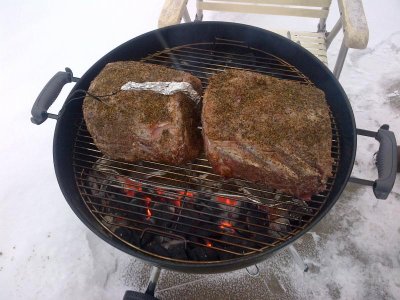Pasmadj
Got Wood.
Hello All.
At Christmas in Michigan (cold), my brother and I cooked a 20lb bone-in ribeye roast. It was AWESOME.
Equipment: Weber 22.5 with ash catcher. iGrill
Setup: Foil pan (no water) in the middle of the coal grate to catch drippings, and form walls for the coals on eaither side. White hot coals on each side as deep as the foil pan and cooking grate would allow. We cut the roast in half - so that there would be 4 ends that would be a bit more done than the rest of the meat. I used my iGrill to monitor the cooker temp and the meat internal temp. We put the ambient probe above the cooking grate, in between the 2 halves of the roast.
Cook: after we put the meat on and put on the lid, the temp display on my iGrill max'd out. That means the temp was over 400 degrees. We cooked like that until the internal probe read 125 degrees. We pulled the meat, let it rest for 20 minutes or so, and then served it. It was perfect - best ever.
My brother went home to Colorado and recently repeated the same thing for a party. Same size Weber. Same setup of coals. He said his lid thermometer would not go above 325. We know that temperature measurement is dependent on many things (probe type, location, etc.). Partway through the cook he checked the meat. It was still very raw. He had to put the meat in his oven at 500 degrees to get it to finish in time for the dinner party.
We cannot figure out why his cooking temperature was so much lower than our cook in Michigan.
Vents were open and clear, etc., etc.
The only thing we can figure is wind. Can a breeze in a certain direction cause this? That is the only thing that could be different.
And ideas would be helpful. Thanks.
At Christmas in Michigan (cold), my brother and I cooked a 20lb bone-in ribeye roast. It was AWESOME.
Equipment: Weber 22.5 with ash catcher. iGrill
Setup: Foil pan (no water) in the middle of the coal grate to catch drippings, and form walls for the coals on eaither side. White hot coals on each side as deep as the foil pan and cooking grate would allow. We cut the roast in half - so that there would be 4 ends that would be a bit more done than the rest of the meat. I used my iGrill to monitor the cooker temp and the meat internal temp. We put the ambient probe above the cooking grate, in between the 2 halves of the roast.
Cook: after we put the meat on and put on the lid, the temp display on my iGrill max'd out. That means the temp was over 400 degrees. We cooked like that until the internal probe read 125 degrees. We pulled the meat, let it rest for 20 minutes or so, and then served it. It was perfect - best ever.
My brother went home to Colorado and recently repeated the same thing for a party. Same size Weber. Same setup of coals. He said his lid thermometer would not go above 325. We know that temperature measurement is dependent on many things (probe type, location, etc.). Partway through the cook he checked the meat. It was still very raw. He had to put the meat in his oven at 500 degrees to get it to finish in time for the dinner party.
We cannot figure out why his cooking temperature was so much lower than our cook in Michigan.
Vents were open and clear, etc., etc.
The only thing we can figure is wind. Can a breeze in a certain direction cause this? That is the only thing that could be different.
And ideas would be helpful. Thanks.

